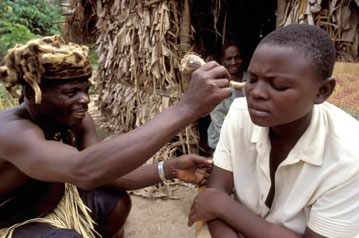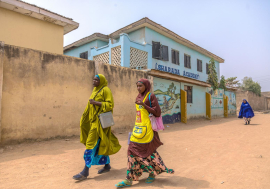Traditional healers boost primary health care
Traditional healers boost primary health care
 A traditional healer in Uganda treating a patient’s dizziness.
A traditional healer in Uganda treating a patient’s dizziness.The sun was relentless. So were the dozens of faces stubbornly waiting to enter the tiny thatched hut in Zimbabwe where Nhamburo Masango, a traditional healer, sat among herbs, bones and other remedies. An old man in front of me had a skin rash, another person a swollen leg, and somewhere a child complained of stomachache. No one, it seemed, was discouraged by the long, winding queue.
For many poor Zimbabweans there is nowhere else to go. Traditional healers are often the first and last line of defence against the most contagious and debilitating diseases that plague their lives. Although Western medicine is generally accepted throughout Africa, it has not replaced but rather augmented indigenous health approaches. Practitioners such as Mr. Masango remain central to the lives of many. The World Health Organization (WHO) estimates that 80 per cent of people in Africa regularly seek their services.
Yet healers, for the most part, are not officially recognized by governments. They operate outside formal health structures. But leaving traditional healers on the sidelines can have serious consequences. Some patients, preferring the healers, may disregard their doctor’s advice or take herbal medicines that could have dangerous interactions with pharmaceuticals. By working with these healers, doctors would be gaining allies who live in the patient’s own community.
“We have, for a long time, been telling the government that they cannot go it alone in the delivery of health,” Gordon Chavhunduka, the director of the Zimbabwe National Traditional Healers’ Association, told a reporter in August. “There has been a lot of tension between the government and us over our usefulness.” Prohibitive medical costs also make it impossible for the poor to get medical attention, he added. People are opting for traditional healers, who do not always demand cash up front and who far outnumber doctors.
But the issue goes beyond access. Traditional healing is linked to wider belief systems and remains integral to the lives of most Africans. People consult traditional healers whether or not they can afford medical services. In my own case, I could afford the best health care Zimbabwe could provide. Two weeks before coming home for a visit, I had undergone an exhaustive medical examination at one of the better hospitals in the US city of Boston, where I lived at the time. In Zimbabwe, although I was not in dire need of medical attention, my mother insisted that I have another “check-up” before going back to the US. There are some things Western medicine cannot fathom, she insisted.
Doctors trained in the Western sciences largely focus on the biomedical causes of disease, while traditional beliefs take a more holistic approach. In Zimbabwe, traditional healers are reputed to divine the cause of a person’s illness or social problems by throwing bones to interpret the will of dead ancestors. Some healers say they directly channel the ancestral spirit through their bodies. Many have in-depth knowledge of plant materials and their various curative powers. They use leaves, seeds, stems, bark or roots to treat symptoms. Animal parts and minerals are also employed, but to a lesser extent. Most traditional healers are both herbalists and diviners, but some specialize in one aspect. Many doctors believe healers to be charlatans, preying on the superstitions of local families. This is true in some — but not all — cases.
Regulating traditional healers
The gulf between modern and traditional practitioners has narrowed somewhat in the past decade. WHO advocates incorporating safe and effective traditional medicine into primary health-care systems. In 2002, the organization issued its first comprehensive guidelines to help countries, such as Zimbabwe, develop policies to regulate traditional medicine.
The Zimbabwean government announced in July that it will regularize the trade. Plans include forming a healers’ council that will, among other things, authenticate the efficacy of herbal medicines. Minister of Health and Child Welfare David Parirenyatwa expressed concern that some healers claim to posses cures for various terminal ailments, among them HIV/AIDS. There is no way to evaluate such claims without a council representing all the healers, he explained.
“There is need for some standardization of operations,” Dr. Parirenyatwa suggested during a meeting with local traditional healers. “For instance, people should be able to consult registered and licenced traditional healers at proper premises. Currently, traditional healers are operating in all sorts of places like truck stops and backyard rooms. That has to change.”
Traditional healers are already a trusted source of health information and treatment. Given appropriate skills and means, they are well placed to play a bigger role in combating Africa’s major diseases.
South Africa leads continental efforts to bring traditional healers into a legal framework. In early 2005, parliament approved a law to recognize the country’s estimated 200,000 healers as health-service providers. Those registered would, for example, be allowed to prescribe sick leave and offer treatment for numerous conditions. Some hailed this as an important step in rooting out charlatans and protecting patients, but others saw it differently. Doctors for Life, which represents over a thousand health practitioners in South Africa, objected to the government’s plans to legitimize healers.
“Most of the medicines used by traditional practitioners have not been validated scientifically,” stated Doctors for Life. “Many people suffer because of the serious complications that arise due to the use of traditional medicines.” The group warned that such a law could open “a can of worms” of legal controversies and medical complications. They urged that remedies be thoroughly researched before approval.
Other medical practitioners point out that traditional healers, with or without the support of the law, are already providing services within communities. Bringing them within the primary-health fold would therefore help rather than hinder efforts to flush out harmful practices.
Collaboration between healers and doctors
There is growing realization that it is possible for traditional and Western practitioners to work together to improve patients’ well-being, especially when it comes to developing new medications, reporting new cases of contagious diseases and finding ways to ensure that patients stick to their prescribed treatments.
In Tanzania, the Dar es Salaam-based Institute of Traditional Medicine has a pilot programme to test the efficacy of local herbs in helping reduce the severity of other illnesses often seen in HIV patients. Herbalists are allowing the institute to evaluate the substances they use to treat patients. If scientists discover beneficial elements in the herbs, they purify them and determine what the proper dosage should be. This addresses a major concern that some people have with the way medicines have been prescribed by traditional healers. Some 25 herbalists are currently working with the institute.
We accept that “some herbs respond positively to some of the diseases associated with HIV/AIDS, and these need to be worked on to understand their functioning,” says Dr. Edmund Kayombo, who is helping the institute establish the effectiveness of traditional herbs. These herbs include remedies for strengthening the immune system, increasing appetite and treating oral thrush, skin rashes and diarrhoea. They cannot be expected to cure HIV, he says, but they can lessen some of the symptoms that occur frequently in people with HIV.
Traditional healers can be particularly effective in monitoring disease outbreaks. They live within communities and are likely to be the first to know if any new disease surfaces. Ms. Nora Groce and Ms. Mary Reeve, medical anthropologists, argue that open lines of communication between traditional healers and the medical community could tremendously improve surveillance. Health officials must include traditional healers in their educational outreach to doctors and must be trained to know what information they should request from healers.
“Traditional healers must be taught why, what, when and how to report unusual symptoms in their patients to local officials,” Ms. Groce and Ms. Reeve state. Checklists or pictorial guides to symptoms, diseases and modes of transmission could facilitate communication between healers and officials, they say.
To an extent, an informal system of referral already exists between traditional practitioners and doctors. But traditional healers complain that information largely flows in only one direction. “Traditional healers already send referral letters to clinics,” notes Dr. James Hartzell, a professor at South Africa’s University of KwaZulu/Natal medical school. They “are just asking for at least basic information back from the biomedical team, which is often hostile to them, such as what were patients given in terms of treatment.”
Dr. Hartzell is working on a project to improve collaboration between doctors and healers in caring for people with HIV/AIDS. It includes training 350 healers in prevention, voluntary counselling and testing, home-based care and antiretroviral therapy. He believes patients listen well to traditional healers. That gives healers the potential to make “a big impact on patient compliance and management, with good collaboration from the biomedical team.”
Healers boost patient compliance
Traditional healers are already a trusted source of health information and treatment. Given appropriate skills and means, they are well placed to play a bigger role in combating Africa’s major diseases.
The incidence of tuberculosis (TB) was on the rise in the Hlabisa district of KwaZulu/Natal, up by 360 per cent in the seven years prior to 1999. TB can be easily cured if patients take their medication every day and complete the course. But with the treatment lasting between six and eight months, many drop out. However, an innovative partnership between medical and traditional practitioners helped reduce the spread through a course that trained healers to supervise and record the doses taken by each patient to ensure proper compliance.
“We were also taught about the symptoms of TB, so that when we pick them up in any of our other patients, we can refer people for a test,” said Jack Nyawuza, one of the 25 traditional healers who volunteered in the campaign. “This information added to what we learn in our training as healers.” Patients were delighted that the healers received this training: the healers lived nearby and could make home visits when patients were too sick to go to them.
The results were quite remarkable. Overall, 89 per cent of those supervised by traditional healers completed treatment, compared with 67 per cent supervised by other volunteers. And the death rate of traditional healers’ patients was two-thirds lower. Healers welcomed their newfound respect within the medical community. “I was trained to help and heal people, so being the TB treatment supervisor is a continuation of my profession,” Mr. Nyawuza said.
Many traditional healers are willing to incorporate standards of Western medicine. In Zimbabwe, following a massive government campaign to end practices that could facilitate the spread of HIV, healers condemned using a razor blade, needed to cut the skin when medication must be rubbed into the flesh, on more than one person.
Luckily — since I have a low threshold for pain — the medication Mr. Masango prescribed for me did not call for any cutting. I keep the bitter-sweet red root he prescribed for headaches next to my Imitrex from GlaxoSmithKline. I enjoy the best of both worlds.
















